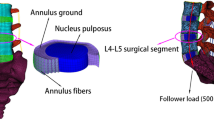Abstract
Introduction
Aim of the study was to evaluate the biomechanical stability and the clinical efficacy of a lumbar interbody fusion obtained by single oblique cage implanted by a posterior approach.
Method
Through the realization of three finite element models (FEMs), the biomechanics of POLIF was compared to PLIF and TLIF. Ninety-four patients underwent interbody fusion by POLIF with instrumented posterolateral fusion. Clinical and radiographic outcomes were evaluated at regular intervals for at least 6 months.
Results
The FEMs showed no statistically significant differences in stability in compression and flexion–extension. Mean preoperative VAS score was 7.1, decreased to 2.1 at follow-up. Mean preoperative SF-12 value was 34.5 %, increased to 75.4 % at follow-up. All patients showed a good fusion rate and no hardware failure.
Discussion
POLIF associated to instrumented posterolateral fusion is a viable and safe surgical technique, which ensures a biomechanical stability similar to other surgical techniques.




Similar content being viewed by others
References
Enker P, Stefee AD (1994) Interbody fusion and instrumentation. Clin Orthop 300:90–101
Kuslich SD, Danielson G, Dowdle JD et al (1998) The Bagby and Kuslich method of lumbar interbody fusion. History, techniques and 2-year follow-up results of a United States prospective, multicenter trial. Spine 23:1267–1278
Mc Afee PC (1999) Interbody fusion cages in reconstructive operations on the spine. J Bone Joint Surg Am 81:859–880
Eck KR, Bridwell KH, Ungacta FF et al (2000) Analysis of titanium mesh cages in adults with minimum two-year follow-up. Spine 25:2407–2415
Zhao J, Hou T, Wang X, Ma S (2003) Posterior lumbar interbody fusion using one diagonal fusion cage with transpedicular screw/rod fixation. Eur Spine 12:173–177
Tencer AF, Hampton D, Eddy S (1995) Biomechanical properties of threaded inserts for lumbar interbody spinal fusion. Spine 20:2408–2414
Mummaneni PV, Haid RW, Rodts GE (2004) Lumbar interbody fusion : state of the art technical advances. Invited submission from the joint section meeting on disorders of the spine and peripheral nerves. J Neurosurg Spine 1:24–30
Zhao J, Hai Y, Ordway NR et al (2000) Posterior lumbar interbody fusion using posterolateral placement of a single cylindrical threaded cage. Spine 25:425–430
Chiang MF, Zhong ZC, Chen CS, Cheng CK, Shih SL (2006) Biomechanical comparison of instrumented posterior lumbar interbody fusion with one or two cage by finite element analysis. Spine 31:E682–E689
Molinari RW, Sloboda J, Johnstone FL (2003) Are 2 cages needed with instrumented PLIF? A comparison of 1 versus 2 interbody cages in a military population. Am J Orthop 32:337–343
Suh KT, Park WW, Kim SJ, Cho HM, Lee JS, Lee JS (2008) Posterior lumbar interbody fusion for adult isthmic spondylolisthesis. A comparison of fusion with one or two cages. J Bone Joint Surg Br 90:1352–1356
Schiffman M, Brau SA, Henderson R, Gimmestad G (2003) Bilateral implantation of low-profile fusion cages: subsidence, lordosis, and fusion analysis. Spine J 3:377–387
Lenke LG, Bridwell KH, Bullis D et al (1992) Results of in situ fusion for isthmic spondylolisthesis. J Spinal Disord 5:433–442
Galbusera F, Schmidt H, Neidlinger-Wilke C, Gottschalk A, Wilke HJ (2011) The mechanical response of the lumbar spine to different combinations of disc degenerative changes investigated using randomized poroelastic finite element models. Eur Spine J 20:563–571
Schmidt H, Heuer F, Drumm J, Klezl Z, Claes L, Wilke HJ (2007) Application of a calibration method provides more realistic results for a finite element model of a lumbar spinal segment. Clin Biomech (Bristol, Avon) 22:377–384
Wilke HJ, Wenger K, Claes L (1998) Testing criteria for spinal implants: recommendations for the standardization of in vitro stability testing of spinal implants. Eur Spine J 7:148–154
Onesti ST, Ashkenazi E (1998) Threaded fusion cage for posterior lumbar interbody fusion. Neurosurgery 42:200–205
Huang KF, Chen TY (2003) Clinical results of a single central interbody fusion cage and transpedicle screws fixation for recurrent herniated lumbar disc and low grade spondylolisthesis. Chang Gun Med J 26:170–177
Wang ST, Goel VK, Fu CY et al (2004) Posterior instrumentation reduces differences in spine stability as a result of different cage orientations an in vitro study. Spine 30:62–67
Lund T, Oxland TR, Jost B et al (1998) Interbody cage stabilisation in the lumbar spine; biomechanical evaluation of cage design, posterior instrumentation and bone density. J Bone Joint Surg 80:351–359
Harris BM, Hilibrand AS, Savas PE et al (2004) Transforaminal lumbar interbody fusion : the effect of various instrumentation techniques on the flexibility of the lumbar spine. Spine 29:E65–E70
Fogel GR, Toohey JS, Neidre A, Brantigan JW (2007) Is one cage enough in posterior lumbar interbody fusion: a comparison of unilateral single cage interbody fusion to bilateral cages. J Spinal Disord Tech 20:60–65
Author information
Authors and Affiliations
Corresponding author
Ethics declarations
Conflict of interest
The author declares they have no competing interest.
Rights and permissions
About this article
Cite this article
Zagra, A., Scaramuzzo, L., Galbusera, F. et al. Biomechanical and clinical study of single posterior oblique cage POLIF in the treatment of degenerative diseases of the lumbar spine. Eur Spine J 24 (Suppl 7), 924–930 (2015). https://doi.org/10.1007/s00586-015-4273-7
Received:
Revised:
Accepted:
Published:
Issue Date:
DOI: https://doi.org/10.1007/s00586-015-4273-7




